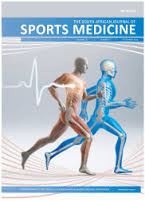The effects of a four weeks combined resistance training programme on cricket bowling velocity
DOI:
https://doi.org/10.17159/2078-516X/2021/v33i1a9002Abstract
Background: Despite the importance of resistance training for cricket pace bowlers, there is limited research displaying meaningful improvements in ball release velocity following resistance training.
Objectives: The study aimed at investigating the effects of a four weeks combined resistance training programme on ball release velocity in club cricket pace bowlers.
Methods: Eighteen adult male club level pace bowlers were allocated into a combined resistance training (CRT) group or a traditional cricket training (TR) group. The CRT group (n=9) performed two training sessions a week for four weeks, consisting of a combination of core and lower body strength exercises, plyometric exercises, and weighted implement training. The TR group (n=9) did no resistance training and only bowled with regular weighted cricket balls. Pre- testing/post-testing variables were ball release velocity, bowling accuracy, and upper and lower body neuromuscular performance.
Results: The CRT group significantly increased their ball release velocity by six percent (5.1 km·h-1), effect size (ES) =0.65, p<0.001) after four weeks of training, while there was no significant difference in the TR group (0.00 km·h-1, ES=0.0, p=0.674). There was no statistically significant difference in the bowling accuracy and lower body neuromuscular performance for both groups and the upper body neuromuscular performance for the CRT group.
Conclusion: This study provides evidence of a combined resistance training programme that can be used to improve bowling velocity in cricket pace bowlers. This increase in ball velocity was not related to any of the neuromuscular performance variables measured.
Downloads
Downloads
Published
Issue
Section
License
The South African Journal of Sports Medicine reserves copyright of the material published. The work is licensed under a Creative Commons Attribution 4.0 (CC BY 4.0) International License. Material submitted for publication in the South African Journal of Sports Medicine is accepted provided it has not been published elsewhere. The South African Journal of Sports Medicine does not hold itself responsible for statements made by the authors.
How to Cite
- Abstract 616
- PDF 610





.png)